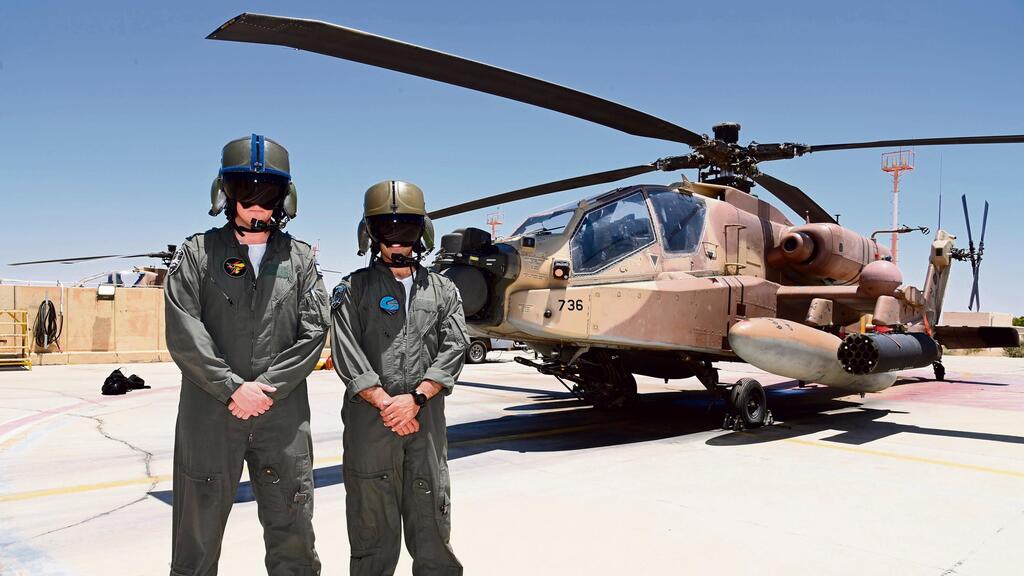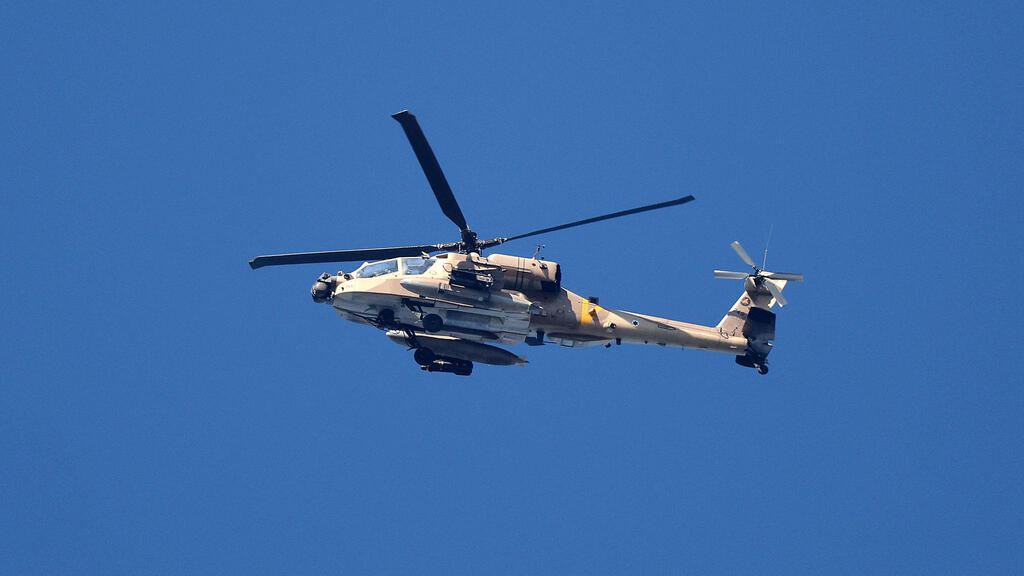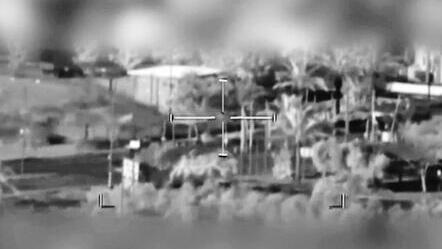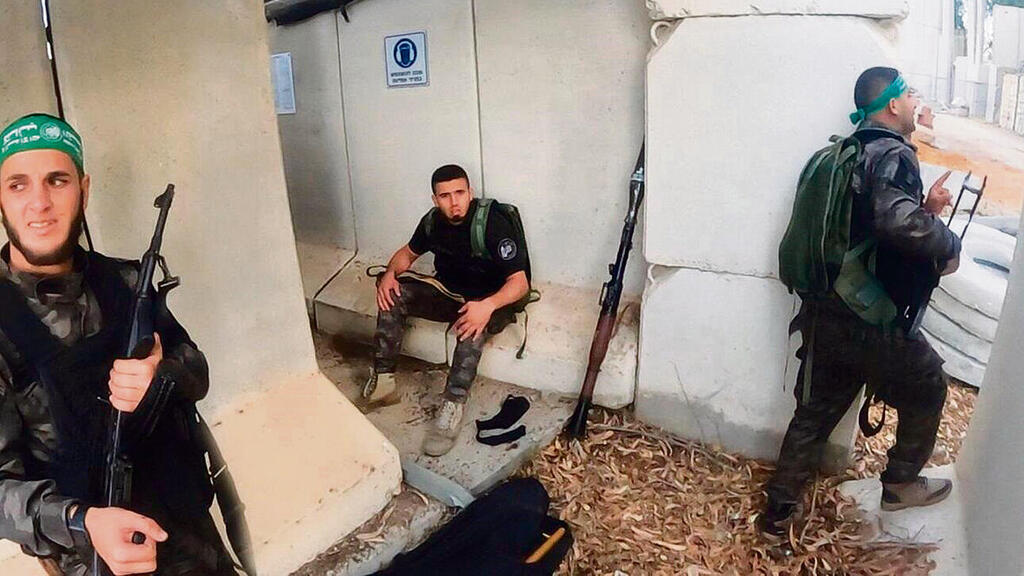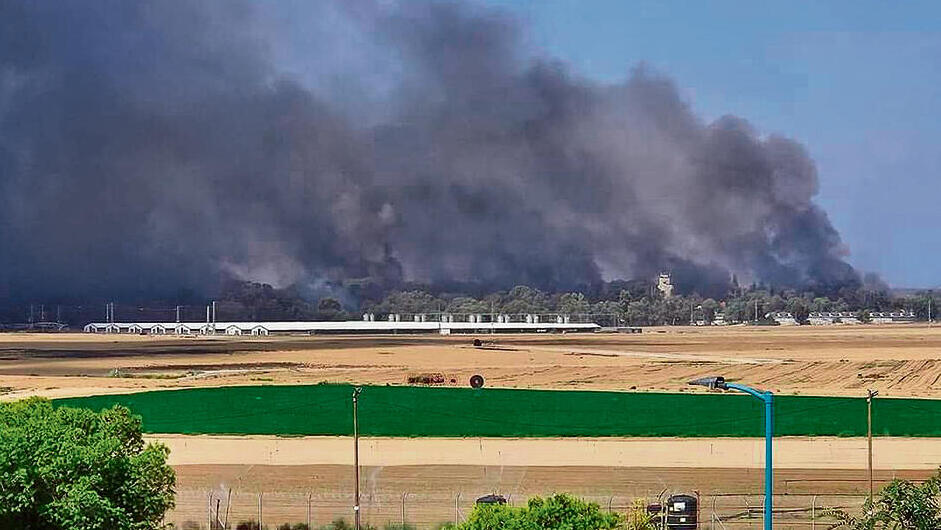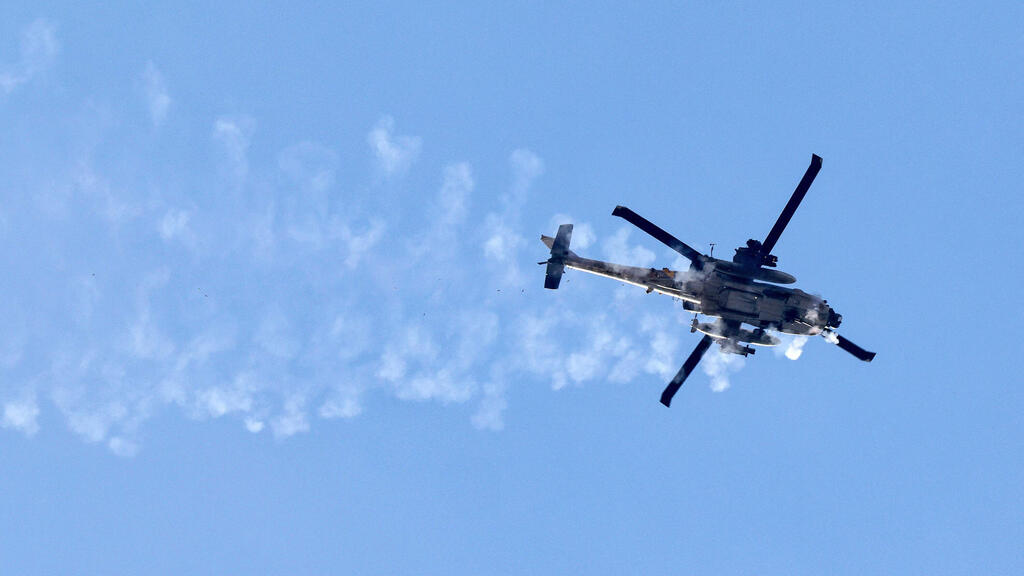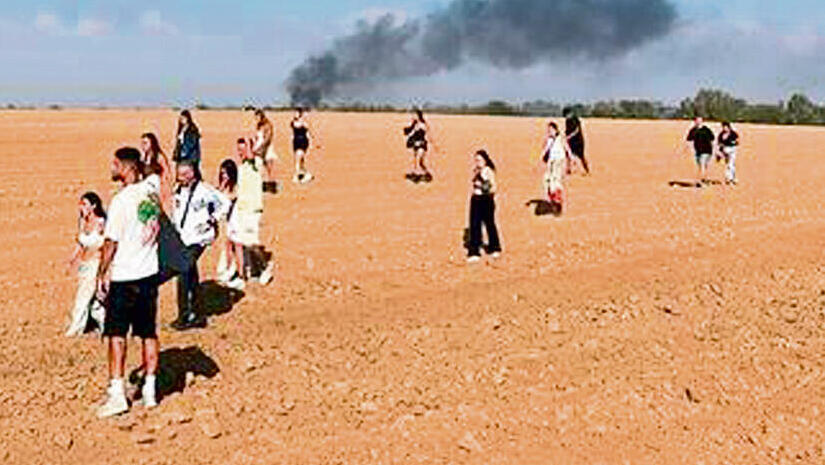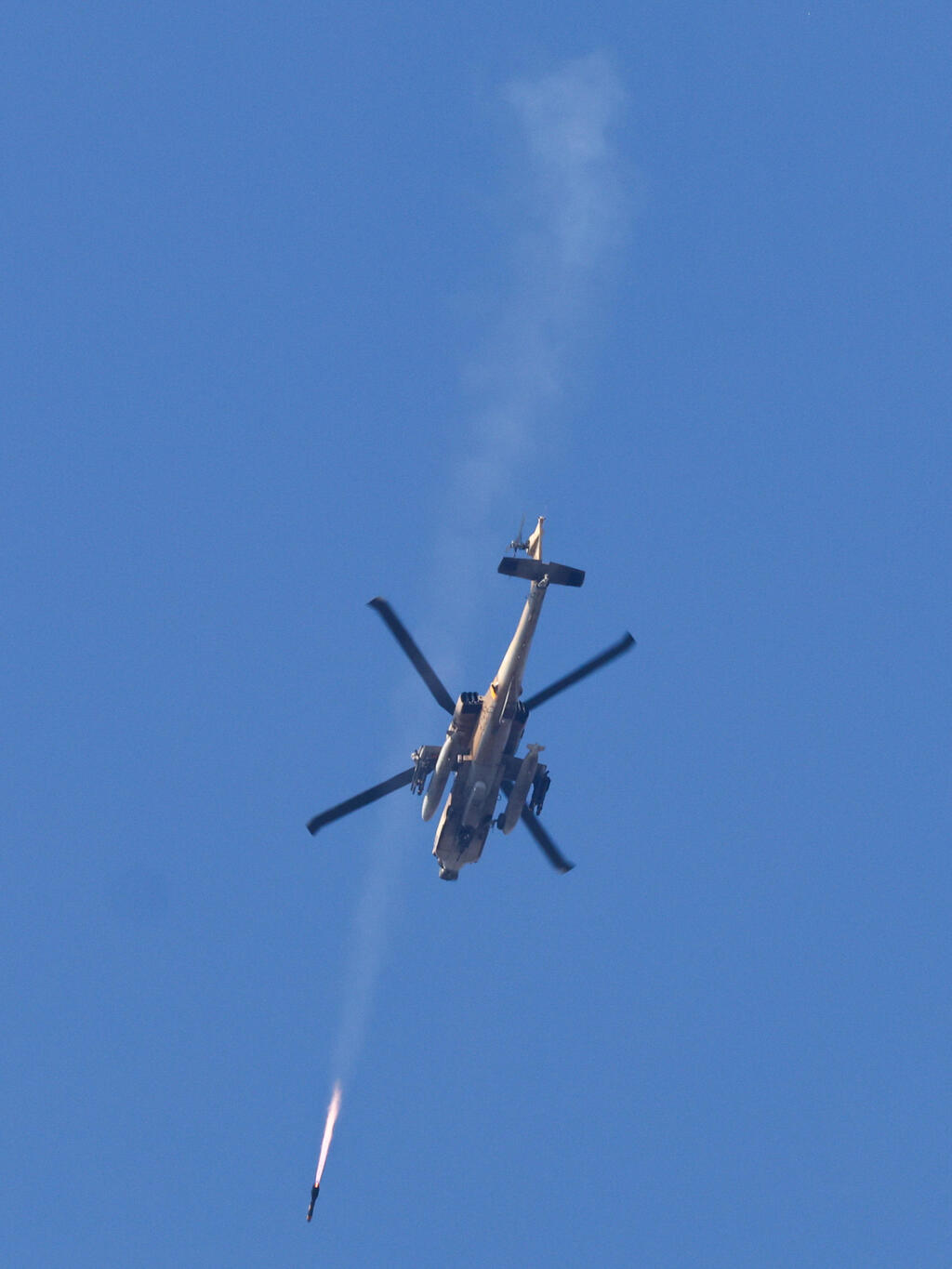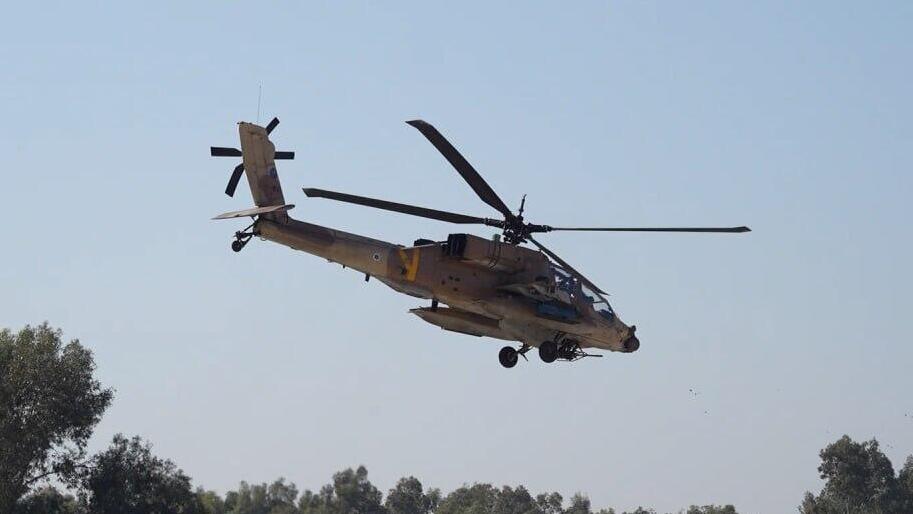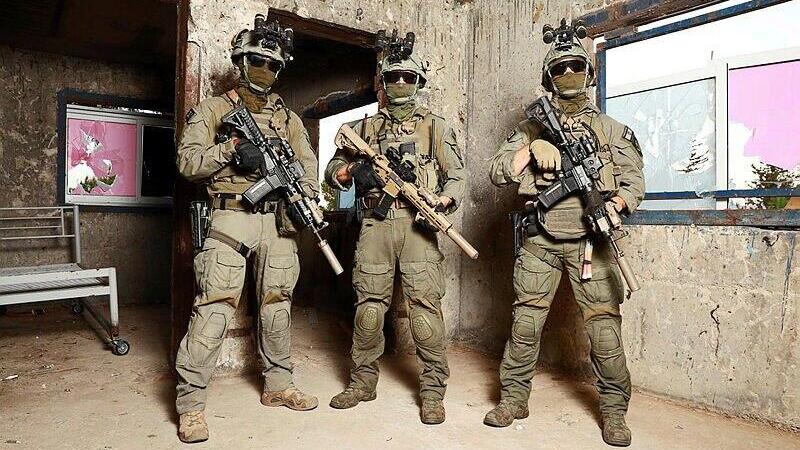On the last night of Chol Hamoed Sukkot, 113th Squadron veterans organized an event 50th anniversary commemorative event of the Yom Kippur War at the Israel Airforce Center in Herzliya. Guests included the squadron’s commanders, past and present including the current commander, Lt. Col. E.
The vets emotionally regaled how the total surprise that befell them half a century ago and how, despite everything, they responded quickly and decisively. In October 1973, the 113th Squadron operated jet aircraft that went out on hundreds of sorties and took down 56 enemy planes.
Today, the 113th Squadron operates attack helicopters including the most advanced Apache model – a flying war machine with immense firepower. The Israeli Air Force (IAF) has only one other Apache squadron – the 190th that last Sukkot was silent.
From this very moving evening, E. returned home to the officer’s neighborhood at the Ramon IAF base from which both Apache squadrons operate and was planning to spend the holiday weekend with his family. His squadron was on standby at the Ramat David base in the north and hadn’t received orders or instructions on Erev Simchat Torah to change anything.
The IAF’s entire helicopter array held a total of four helicopters on standby: two to be deployed immediately within minutes to the northern border ("short standby"), and two more that could be added if necessary ("long standby"). That’s all. E.: "Following situation assessments before the holiday, it was decided that there was no need to shorten the standby for Gaza, and all the helicopters and crews on standby were transferred to Ramat David."
Was the short standby in place at the IAF's Ramat David base due to the understanding that if a significant incident were to develop, it would be in the north?
Lt. Col. E.: “Throughout the years, with the exception of specified situation assessments, standby has always been prioritized in the north. The understanding is that under routine circumstances, the northern border is the hotter one.”
Two helicopters on standby for any eventuality sounds very little
Lt. Col. A., 190th Squadron commander: “Today, looking back, that’s clear. We used to have 100 helicopters in the IAF. We’re now down to a few dozen, so you start calculating risks accordingly. You need to take into account the number of helicopters, how much training is needed, along with all the ongoing missions and allocate forces accordingly. Since the 2014 Gaza War we’ve had two helicopters on short standby.”
The squadron commanders explain the that flight time difference from Ramat David and the Ramon base the northern Gaza is a marginal five to seven minutes. “That’s at the end of the line” says Lt. Col. E. “It’s getting the people to the helicopters. Most of the reservists live in the center or north of the country. That’s why the standby is shorter there.”
06:30 a.m.
Like the rest of the country, the squadron commanders were woken at 6:30 on Shabbat morning, to a flood of warnings of rockets across the country. Lt. Col. E. called the IAF headquarters at the Kirya to ask what was going on. “The duty officers at HQ said he didn’t know. While we were talking, we received an update from the control room that was communicating with the Operations Directorate, kickstarting our northern standby.”
At 6:51, we received a report of an infiltration from the sea at Zikim. Nine minutes later, there were two helicopters in the air. Lt. Col. E.: “As soon as they took off, without instructions from the control room, we took a decision on our own to shorten the long standby. (i.e. to utilize the other two helicopters.)
Why did you make this decision?
“Because I realized it would be at least a day’s fighting, and as they’d be shortening standby within an hour or two, I’d rather be preemptive about it.”
Meanwhile, 190th Squadron commander Lt. Col. A. also realized something irregular was going on, He called all the pilots to the squadron and instructed his team to start preparing the helicopters for flight. At the time, they didn’t realize that, 50 years on, they were facing their own Yom Kippur.
Like the entire defense system, Israel’s big, strong, daring and sophisticated air force failed on October 7. The reservist pilots becoming a symbol of resistance to the regime change in the preceding months, some declaring they’d stop showing up for training, has made them a special target for criticism, fueled inter alia by political elements. Online postings asking “Where was the AIF on October 7?” are invariably not innocuous, but rather hint at delusional conspiracy theories claiming there was no failure, but rather intentional harm.
For the first time since October 7, the IAF’s two helicopter squadron commanders Lt. Col. A. and Lt. Col. E. opened up that morning’s flight logs. Yes, they say, it was a complete surprise. Yes, there were therefore fewer helicopters in the air in the critical first hours of that difficult morning. But there was tenacious fighting, dozens of sorties killing countless terrorists attested by the activity details of that morning published here for the first time. Does this bring them any comfort?
Unequivocally not.
07:30 a.m.
Half an hour into their flight, the first pair of helicopters to take off from Ramat David were approaching Kibbutz Zikim. But even before they’d gotten there, they received a call from Gaza Division headquarters near Re’im telling them it was already under attack. Lt. Col. E.: “They told them (the pilots) that there were now terrorists at the gate and they’re being transferred to assist the forces at the army base.”
The helicopters were there within ten minutes, contact the situation room at Re’im, but then unexpectedly identified fire in their direction from the area of the base. “They launched three or four anti-aircraft missiles at them. They dodged the missiles and realized there’s an attempted infiltration into the base as well as ambushes against them within the country’s territory.”
As mentioned, the two squadron commanders, in the meantime, instructed the technical teams to prepare the helicopter for operations at speeded-up procedure. “Routinely, it takes three and half hours to check, carry out maintenance and arm the helicopter before take-off,” explains Lt. Col. E. “but I told the technical officer to use emergency procedure.”
What does that mean?
“Basically, they don’t check the helicopter. They fuel it, arm it and take off.”
08:10 a.m.
Lt. Col. A., 190th Squadron commander took off together with another helicopter from the Ramon Base. “They told me to go to Be’eri.”
What do you know at that moment about what’s going on?
“Nothing. Just rocket sirens.”
He gets to Be’eri at 08:30 and is asked to assist landing a Blackhawk carrying a Shaldag intervention team to the kibbutz. ”They told me there were five terrorists going house to house on the kibbutz slaughtering civilians. I then saw the helicopter arriving and I fire a cannon so that he can land. Firing a cannon inside our territory is very irregular.”
What do you see when you get to Be’eri?
“On the radio, I hear that terrorists are infiltrating the community. I look at Be’eri via the (helicopter) surveillance system. Be’eri is a kibbutz covered with trees. I couldn’t really see what was going on inside. I couldn’t see explosions or gunfire or anything like that. I fired a cannon to deter terrorists in the area. The (Shaldag Blackhawk) lands and the intervention team goes in.”
Throughout the day, the helicopters will pass over Be’eri numerous times without knowing about the massacre taking place on the kibbutz. The kibbutz security team say they communicated with the helicopter pilot via the Shaldag forces at the kibbutz asking him to fire at the kindergarten where 50 terrorists were holed up. They claim that the pilot’s response was negative, saying he didn’t have permission to fire inside the community. “This report didn’t reach any helicopter”, says Lt. Col. A., explaining that sweeping permission was swiftly granted to fire within our territory.
08:35 a.m.
After the Shaldag fighters entered Be’eri, the pilot of the second helicopter that had taken off with Lt. Col. A. reported he could see a breach in the border fence area. “And I saw something that looked like a Friday demonstration that had gotten out of control.”
Lt. Col. A. has a rich resume when it comes to Friday demonstrations on the Gaza fence where instructions are very clear: “Every now and then, a few demonstrators will cross the fence. We fire in front of them and they run back.” This time, however, things were very different and Lt. Col. A. realizes that the breach in the fence and the incident at Be’eri are related.
“There was a reference scenario (a process that is likely to take place and for which preparations are made) of an infiltration under the cover of the demonstration. So, I started firing at them just to make them run away. I fired for ten minutes and then ran back. As far as I was concerned, the incident was over.”
“But then the northern brigade communications man directed me to another infiltration incident, on the separation fence in the Nahal Oz area. This time, Lt. Col. A. decides to shoot to kill.
Why did you suddenly decide to shoot to kill?
“Just because by now, it’s two incidents. I thought to myself: one plus one is enough.” This is at about 08:58.
But what were you thinking? That it wasn’t a demonstration?
“I don’t know if I was thinking it wasn’t a demonstration as much as this was an organized, wide-scale situation, not an isolated incident. I then identified a Hamas van by the fence and I fired a missile at it.”
Do you need permission before firing like that?
“Yes, but no. I told the controlling officer I was firing. She said ‘one moment’ and I said to her ‘fire, fire,’ and then she authorized it. I didn’t really wait for her authorization.
But then, something strange happened. “The vehicle exploded and everyone next to it on the Gazan side of the fence ran into our territory, into Israel, so I fired at them.” This was so irregular that Lt. Col. A. stopped asking for permission to fire for the rest of the day.
Along with the two helicopters from the 190th Squadron at Ramon and the pair from Ramat David 113th, Squadron commander Lt. Col. E. also takes to the air. As mentioned, the first two helicopters the squadron sent had entered battle over the Re’im base. Lt. Col. E.: “The division directed them to fire at the terrorists at the gate. They saw a group of motorcyclists, but they know it’s Shabbat morning and it could be a group of friends out for a ride.
11 View gallery
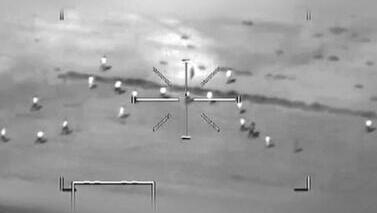

Attack helicopter opening fire near Nahal Oz IDF base
(Photo: IDF Spokesperson's Unit)
The division’s situation room, however, insisted that the people outside the gate were terrorists and the pilots respond, shooting and finding a cell hiding in ambush and fired missiles at them. Both squadron commanders say this was the moment they made the switch in their minds that Shabbat.
“They took off thinking that firing within our territory constituted an incident with greater potential for damage than benefit,” says. Lt. Col. E. “Looking through our (helicopter) surveillance cameras, it’s hard to see if a person has a green band on his head or a round Kalashnikov magazine. It’s good if I can see he has a gun at all. So, you have to be extremely careful when firing. But when you hear it over and over again on the radio, you get it.”
Helicopter Communication above Re’im:
Northern Brigade Officer: “Outside the Re’im base gate, we have terrorists trying to get enter the base. We need to surround it as soon as possible.”
Pilot: “Received. Those are the terrorists that fired a shoulder-fired missile at me.”
Northern Brigade Officer: “There are terrorists at the gate to Re’im at Nesher Zippor (location code) that I gave you. You need to operate.”
Pilot: “Going in to operate now. The field’s open a little east of the road entering the base.”
Fires
Pilot: “Hit on the road junction to the east.”
Northern Brigade Officer: “I want you to survey the gate. I encountered 15 terrorists there. In the olive grove outside the gate. In the olive grove.”
Pilot: “We’re assisting them with forces. We’re in communication with them. Only execute (fire) at open terrain.”
Control Room: “Received. Permission to fire at open terrain.”
Northern Brigade Officer: “Execute in open terrain. Also watch out for people escaping. Permission granted.”
Fires
Pilot: “Hit! Alpha (hit the target).”
Do you even have a battle plan for an attack like this from the south?
Lt. Col. E.: “Yes. Since the 2014 Gaza War, we’ve been training for infiltration incidents in our territory, but we never imagined a reference scenario of this magnitude of a number of communities being infiltrated simultaneously.”
To be clear: There was an infiltration scenario and firing at terrorists in our territory does exist. It exists in our understanding, but it’s very extreme in our understanding. To get there, you must know that this is your only option, because in a battle plan where a soldier encounters a terrorist, it’s better to shoot him than firing mortars with a 100 square meter fall out range.
What to your pilots see at the Re’im gate?
“They see the battle going on there – people running back and forth between the gate and the trees. They construct a picture and realize that these are definitely neither civilians nor our forces. They shoot and hit a group of terrorists inside the trees next to the parking lot. They kill six or seven. Before finishing the battle, they’re sent to another incident taking priority, and they move south.”
The division doesn’t ask them to say and carry on firing at the terrorists?
“The division tell them to move, that there’s another incident taking higher priority. They transfer them to work with the Southern Brigade.”
But if the division command falls, response capabilities are damaged
“Everyone’s goal is protecting the communities. I don’t know of a commander in the army who would put the division, brigade or outpost above the community. I just don’t."
This modus operandi, transferring helicopters every few minutes from one place to another, carries on all morning. “Every five or six minutes, we were receiving call-outs to another incident,” says Lt. Col. E. “You can’t construct a picture as to where the more urgent thing is, so you go where they tell you.”
In hindsight, is this system of going from one spot to the next an effective method?
“If we’d have stayed in the same place the whole time with other forces - and there were cases like that - we might have prevented something from happening. But it affects the overall aggregate of what was going on at each separate battle at the same time. You can’t foresee what you’ll prevent at a given point.”
His colleague from the 190th Squadron, Lt. Col. A. says this question is hard to answer before investigations are completed. “There were places that helicopters finished off the incident in an hour, while in other places, helicopters operated for hours without bringing the incident to an end. Why? Perhaps there were fewer terrorists there, or maybe it was harder to get our forces in.”
Lt. Col. A., where do they send you next?
“The Northern Brigade intelligence officer was directing me. Each time, he’d tell me there was in infiltration here or there, and I’d go from one infiltration to the next, firing at terrorists between them. I also need to economize with my ammunition, so I was passing over, dripping fire, just to finish off the incident.”
What did you see next to the fence?
“I saw sinkholes, smoke and fires. They burnt the cameras and the antennas.” It’s now sounding like an incident on a much larger scale than Friday demonstrations getting out of control. At 08:45, after they fled from the fence toward Nahal Oz, I hear on the radio about another site. I Now realize this is a war.”
09:00 a.m.
At 9 a.m., two and a half hours after the attack began, there were six Apache helicopters - three from each squadron - in the air Some of the hostages are already in Gaza by this point, but the squadron commanders don’t know this. Lt. Col. A. is above the Gaza border fence and has to make decisions on his own.
“They told me there was an incident at Kfar Aza. I looked at the kibbutz, saw a truck and fired at it. I then got closer and saw that it was a closed truck was closed and thought it wasn’t definitely terrorists as the terrorists had open trucks, so perhaps it was the community security coordinator. The missile was already on its’ way. It has 20 seconds flight time. I’m very close and I can’t see terrorists around the truck. Three seconds to the hit and I veered the missile aside. It exploded and I didn’t see anyone leaving the truck. No one moved. I left the vehicle and carried on.”
At the same time, Lt. Col. E. received a report of an infiltration at the Nahal Oz outpost. “I move onto the frequency of the force at the outpost and he started telling me about an infiltration from the northwestern corner. I aim the surveillance system there and see 40 people in light-colored shirts. I ask him if he’s sure these are terrorists. I said ‘affirmative’ and we go into action, firing two missiles, killing a significant number of them.”
The terrorists fled and the helicopters carried on, chasing after them, firing missiles.
Helicopter Radio Communication:
Nahal Oz Outpost Ground Force: “Can you see anything?”
Pilot A.: “Affirmative. Northwest, I identify a huge group of people at Nahal Oz. are they terrorists? Team 1, we’ve already fired 200 shells. There are lots of people in the field and on the road, definitely incriminating motorbikes, and all the people in the field are incriminating.”
Pilot B.: “Okay”
Fires a missile
Ground Force: “The terrorists are beginning to move back toward Gaza! They’re running toward Gaza.”
Ground Force: “Carry on. Missile”
Pilot B.: “Okay.”
10:00 a.m.
The ammunition in Lt. Col. A.’s helicopter has run out and he returns to base at Ramon. He lands at 10:20 and gathers his pilots for briefing just moments before they board the helicopters. “I caught each of them by their clothing, looked them in the eye and said, “Listen, you’ve never seen anything like this before. This isn’t a Friday demonstration.
"Our forces aren’t there. Lots of terrorists are infiltrating our territory. Anyone you see infiltrating out territory is a terrorist. Kill them all. You’re going to a war.” The briefing took a minute, but as a commander, it was my responsibility to make it click for them that this is a quite different kind of incident.”
When did it the possibility of hostages cross your mind?
“I have to admit it didn’t. There were reference scenarios. I didn’t think of that.”
Despite reports of hostages appearing in the media since the early morning hours, Lt. Col. E. admits he didn’t realize that was a possibility. “The first report about an abducted soldier came in at 12:30. We didn’t get it before that. At around 12:45, I saw people the other side of the fence and someone carrying a wounded person.
"I couldn’t tell whether it was an injured terrorist, or a body of ours they’d kidnapped. I saw a vague dark blood stain in the shape of a person and I had no one to ask. Only I saw it. This was the first time I started thinking whether it was the enemy or a kidnapped person.”
What did you decide to do?
“It’s one of the greatest dilemmas I’ve ever faced as an airborne fighter. I see them reaching an ambulance on the other side of the fence. Firstly, this increases the chances of it being one of their wounded. This is how I analyze the situation.
"Secondly, there are further bad partners to this incident and I decide to fire. The way they were carrying him I assumed it was a body or someone severely injured. I ultimately hit the ambulance along with these people. I still don’t know, and maybe never will, what that was. It was an impossible decision. But I think that if we had decided not to operate at any point like that, it would have been much worse.”
There was a case when the helicopter was operating over Nir Oz that ended tragically. “It’s important to understand the context: What do you see when you look at the kibbutz from the air? You see trees and smoke rising” says Lt. Col. A. “But the height and diagonal angle means you can’t see specific houses burning. And even if you do see people, what do you do? Fire at them? You don’t know who they are. Maybe it’s the kibbutz security team or the intervention team. You just don’t know anything.”
But in the strip between Nir Oz and the fence, there were streams of people going in and out. One of them had a trailer attached to a tractor carrying nine hostages from the kibbutz toward Gaza. I don’t know what the pilot could see from the air, but he opened fire at the tractor and hit the terrorists, but one of the hostages, Efrat Katz, was hit and killed by the fire.
The rest of the hostages fled, but another tractor showed up and picked up the rest of the hostages, except for one, Naamit Dekel-Chen who attested to the incident. We asked the squadron commanders about this incident, but they declined to address the matter, explaining that an extensive operations investigation is underway, headed by the AIF commander and its conclusions will be passed on to the family.
They do say that the helicopters operated in the Nir Oz area 09:30 – 12:30. Lt. Col.:” We fired at the path from the fence to the kibbutz and we killed lots of people. I think we killed the largest number of terrorists at Nir Oz. They found over 200 terrorists’ bodies there. It didn’t, however, change the picture. Terrorists got there and didn’t stop coming. It was insane. No matter how many we killed, how much we fired, they just kept coming, travelling through the bodies. “
Security forces only got to the kibbutz in the afternoon. Did you have anyone to talk to?
“There was no army at Nir Oz until the afternoon. That’s accurate. There was no one to talk to.”
It’s an important point that must be stressed. “Helicopters have a weak spot. They’re ineffective without anyone directing them from the ground. So, when Lt. Col. A. is asked if he knew what was going on at the party near Re’im, he gives a surprisingly honest answer.
“It’s a stroke of good fortune we didn’t go to the Nova Music Festival. I don’t know who we’d have killed there. If you were to tell a pilot that there are lots of terrorists there, and he should make it to Nova, and see that amount of people, what does he know? You must understand, what you see in the picture is black figures.”
There are also reports of helicopters operating at Nova. Moran Stella Yanai who was kidnapped to Gaza and released, says that as she was being kidnapped, she saw a helicopter in the sky. Did they fire? Did they understand what was happening there? The IDF is still investigating.
11:59 a.m.
Just before noon, there were 11 helicopters in the air. Maj. Gen. Yaron Finkelman of the Southern Command commands the anti-aircraft fire array: "Our top priority for attack is the area of defense and the prevention of attacks.”
i.e. anyone who didn’t have another higher-priority mission was ordered to get there to prevent infiltrations from the fence. And so, at a certain stage, that was the helicopters’ main task. “Fifty percent of what we did that day was an aerial blockade along the fence” says Lt. Col. E. “A little under 10% inside the communities and all the rest was at the outposts.”
This order continues. “Enemy forces must not be allowed to retreat into Gazan territory and any such attempt must be stopped at any cost.” Another part of the order reads: “There must be no passage into Israeli territory and citizens must not be allowed to enter the area in the Gaza Strip.” Did this constitute a hint at the Hannibal Directive, i.e. the possibility of also hitting hostages?
The squadron commanders say that wasn’t said and that wasn’t the intention. “I heard the Southern Command’s commander’s order over the radio” says Lt. Col. A. “He said that anyone coming and going 300 meters from the border, shouldn’t be allowed to leave. It has no bearing on whether there are hostages or not. He didn’t say, ‘Wherever you see hostages, don’t let them get kidnapped. There are lots of terrorists who left the State of Israel with no hostages. They were dead men walking.”
But you see a truck leaving and you don’t know who’s in it
“True. But wherever there was fear of hostages, they reported it and said ‘Watch out, there are hostages.’ It’s not that they said to kill in any situation. That wasn’t the order.”
Let’s imagine there’s a similar incident now in the north. The Redwan Force takes trucks back toward the fence. You don’t know if there are hostages there or not. What do you do?
“Orders on this matter haven’t changed. There’s no intention to fire at hostages to kill. If there’s reasonable suspicion a hostage would be killed, you don’t fire.”
13:00 p.m.
More helicopters and more pilots took off. Lt. Col. E. is once again called to go back to the Re’im base. “A battle went on for the whole day there,” he says. “In the final stage, we joined a special forces unit. They didn’t have a functioning radio and we found ourselves working with them over WhatsApp.”
And what do they tell you?
“That there are terrorists holed up in the sports hall, that this is their last stand and that the forces want to go in there to cleanse the division’s base.”
The soldiers on the ground ask Lt. Col. E. to fire on the hall before the forces go in. “We fired on the hall. Firing inside an outpost – not even at people in open terrain, and being told they’re the enemy - is a weird feeling. I was firing at places I’d been in, places I knew.”
How far was it from the terrorists to the soldiers?
“About 70-80 meters.”
That’s far below the safety range
“Far below. A missile has a safety range of 300 meters. It’s much more than I ever imagined I’d do.”
This combined air and ground forces attack is what ultimately restored control to the base – four hours after the terrorist infiltration.
The attack helicopters carried on fighting throughout the day – 48 sorties in total. That night, they also fired missiles at the police station in Sderot that had been captured. “It really went on until Thursday” says Lt. Col. A. “All the missiles and shells the squadrons fired were within our territory. There were still lots of terrorists scattered in the field.”
Nevertheless, there are quite a lot of people wondering where the Air Force was on October 7
Lt. Col. A.: “With the end results, the public is right. What does it matter what I say? The whole of the IAF was there. Two hours in, the skies were crowded. We were constantly firing shells and missiles. No matter what kind of attack it was, and how fast we ran and brought the whole squadron went to war in full force. Half an hour after the last landing, I finally saw what had happened. I breathed. It was an unbearable dissonance. You fight the then you know the results are not what you would have wanted.”
So, you could say that the IAF was there but it didn’t change the end result. “But there’s good reason why it not. We were very, very surprised. By 07:30, all the communities and outposts had been captured. So, yes, you’re on standby and do your best, and the AIF really did attack. But going by the end results, it’s hard to tell the public ‘We were here. What’s your problem?’ Really not. It doesn’t work like that.”
That’s very discouraging to hear.
“But that’s life.”
Let me tell you a secret. They’ll be another surprise sometime
“But there’s a difference. We need to change our defense thinking. If we don’t, even if there’s another surprise, we’ll win. That’s exactly the difference.”
What needs to change?
“The order of battle needs to change. We have no choice. If we want to be able to deal with 3000 terrorists who get up one morning and decide to infiltrate because we have no warning, then you need to change the order of battle.”
That’s the most important thing that needs to change? Create another squadron?
“That too. But there are other optimization processes. Right now, we’re on standby all the time. It comes at a cost and we’re not training at all. I can’t train, I’m not training the next generation. I’m only fighting. I’m fighting all the time. The squadrons aren’t built for that. If we want to carry on maintaining these missions for years to come, yes, we need more helicopters and more people. Lots of paradigms need to change.”
Like what else for instance?
“The pie needs to be divided up differently. If you were to buy another 40 submarines for example and you’d never be defeated at sea. But the blanket’s too short, right? Maybe we need to use different kinds of vehicles to create the same defense with fewer soldiers. But it always means taking resources away from other places. You can’t have it all.
"The State of Israel is playing on the whole field, defending itself from 300 Iranian missiles one night, the next day killing a terrorist with a knife in Jerusalem, and the day after that, preventing yet another infiltration from Gaza. When you play on the whole field, you need to decide how, how much, and where to invest.”
I repeat. The answer is discouraging
“It’s complex. The way we’re organized now, they can’t do that to us in the north. Can the State of Israel live like this for years to come? The answer is that it looks like we’ll have to. The defense in the north right now is very, very strong.”
People living in Metula would disagree
“They’d disagree when it comes to UAVs and RPGs, but no force is going to cross the border tomorrow and survive long. That’s not going to happen. We’ve built ourselves differently for this eventuality.”
Can you also say that for the West Bank?
Lt. Col. A. pauses, ponders and replies, “Again, we need to decide how we defend and how many forces we allocate. I couldn’t say if in Judea and Samaria it’s at zero. It’s not my field, but I believe we could stop such a forceful incident of massive infiltration.”
What do you have to say to the Bat Hefer residents, who are getting shot at from Tulkarem?
One of the lessons the IAF has learned and has implemented since October 7, is that my flight materials include the phone numbers of all the community security coordinators in the country, including Bat Hefer. I also have the entrances and exits marked as well as the point from which they fire. If I’m called to an incident there, I know where the terrorist’s penetration route is.”
An attack helicopter pilot who participated in Operation Arnon tells us how it looked from above
The combat helicopter crews have been fighting continuously since October 7. One of the jewels in the crown was Operation Arnon, rescuing Noa Argamani, Almog Meir Jan, Andrey Kozlov and Shlomi Ziv. A few days before the operation, 190th squadron helicopter pilot, Maj. A. found himself in a mini family crisis.
His sister-in-law was getting married and he would have to pass on the wedding. His wife, who is also an officer, had almost gotten used to it. For eight months, he’s been in the air more than he’s been at home. But this time it was different. Following weeks of training for a special, secret mission, Maj. A. was notified that he and his friends would be supporting rescuing the hostages from the Nuseirat refugee camp. But, apart from telling her he loved her, he couldn’t elaborate.
Unlike for previous missions, this time the air crew came specially to the ground training area and met the field fighters. “When you meet a person and get to know them on an inter-personal level, you’re connected to them and understand them better “says Maj. A. Then, when you hear them on the radio, you know exactly what they mean.”
On Shabbat, two weeks ago, when the signal was given, the skies were still very crowded. “It’s a combination of fire from helicopters, UAVs and fighter jets, Maj. A explains. And another thing: it was close, very close. Yamam (Counter Terrorism), Shin Bet and IDF forces were operating there. “It’s the closest to our own forces that we’ve ever fired missiles.
What was the distance between the target and the forces?
“Fifteen meters.”
What’s the safety range?
“One hundred meters.”
That means if you move a millimeter with the target finder, you could hit an Israeli soldier or a hostage
“Correct. That’s what we trained for and planned attack angles and we knew precisely where the forces were going in and where they’d be.”
A. says that the forces on the ground were accompanied by a contact person in the field whose role was to constantly communicate with the pilots and the control room at the Kirya. So as not to say long sentences like “The road that leads to the house where the hostage Noa Argamani is held”, each target had a short, pre-determined code name “so one word is enough for us to understand what’s going on with the force and what targets we want to attack.”
Every target has a name?
“Yes. Every house in the area, every situation they’re in, so in 10-15 seconds, we could to aim at the target and the missile would hit within 20 seconds.”
As we know, the operation went as planned – until the rescue vehicle, with the three hostages on it, got stuck. “That moment was very stressful. We had crazy adrenalin pumping. You remember exactly what you were briefed on two hours ago. We divided the sectors and targets with UAVs above us, firing to isolate the force, so that the enemy wouldn’t show up out of nowhere and so that we could send in further standby ground forces.”
The operation still continued even after the fuel gauge went down, signaling Maj. A.’s formation’s return to base. But they understood the rescue mission had been a success, and that there was a soldier seriously wounded. “Like everything in this war,” he says, “the joy is mixed with sadness.”
Did you call your wife to explain why you weren’t at the wedding?
|“Yes, I told her I was sorry and that I hoped she understood why it was so important.”
And what did she say?
“That she’s proud of me. She trusts me totally and that’s why we’re here."



